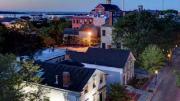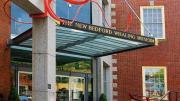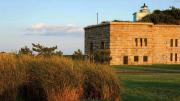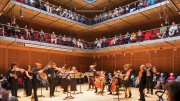People know about New Bedford’s thriving fishing industry, its history as a whaling hub, and its role in inspiring Herman Melville’s Moby Dick. Evidence of that maritime history abounds, especially in the robust permanent displays of art and artifacts at the New Bedford Whaling Museum. But through “In the Neighborhood,” a new exhibition of contemporary works, the museum strives also to shed more light on the wider stories, architecture, and diverse communities that have shaped the city, and still do.
The show highlights a series of large-scale, mixed-media paintings, with collaged newsprint and slashes of color, by local artist Alison Wells, whose studio is part of the thriving downtown arts scene. The works integrate themes past and present, transmitting her passion for the city—and what makes it a fascinating place to visit. “I’ve wanted to show more of the grit of New Bedford, and the beauty of the old buildings and the communities,” she says, “and what I feel and see living and working here.”
Wells left her native Trinidad for New Bedford in 2004. Intent on earning a graduate degree in fine art from the state university, she planned to learn, graduate, and leave. Yet 17 years later, she’s an influential regional artist and teacher with a downtown studio, and this one-woman museum show. “I’m still here,” she says cheerfully, “because I became part of this wonderful arts community and this city, so rich in history.”
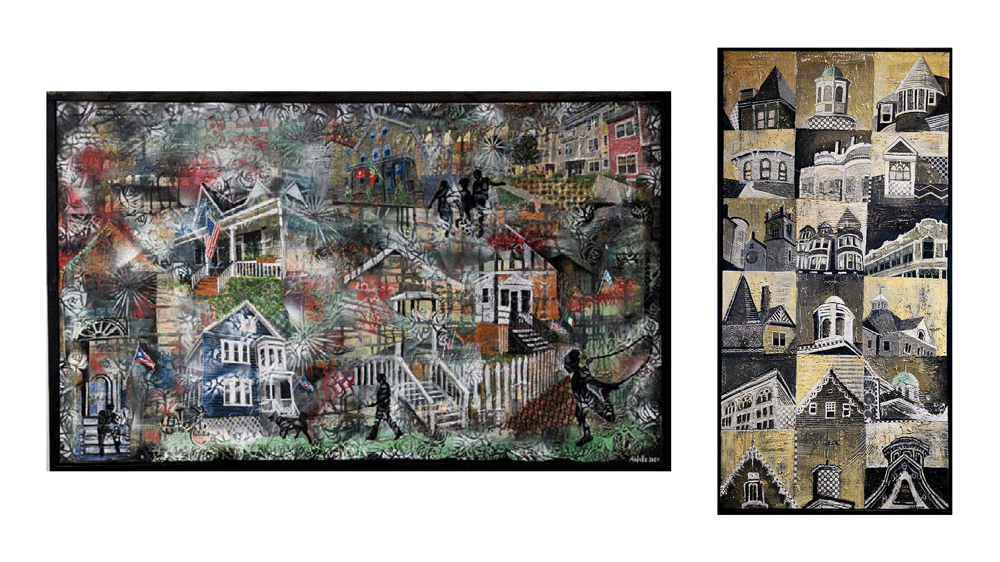
Melting Pot and Rooftop Snippets are among the large-scale collaged paintings by Alison Wells
Alison Wells/Courtesy of the New Bedford Whaling Museum.
Her work, including Rooftop Snippets, Abolition Row Roots, and Melting Pot, filters layered facets of her adopted home through its built landscapes. The 18 squares in Rooftop Snippets are close-ups of turrets, peaks, bay windows, and towers of real buildings—including the cupola atop the whaling museum’s 1916 Bourne building, lit up as a beacon of hope during the height of the COVID-19 pandemic. Rendered in fine lines of black, white, and gray, the spare images, she says, elegantly reveal “different parts of the city—Gothic revival, Italianate, federal style—that stood out and grabbed me.”
Walking is the best way to see and learn about New Bedford architecture and how it evolved as the city’s fortunes shifted. The museum is within the downtown’s designated New Bedford Whaling National Historical Park. Rangers organize events and walking tours. Typically led in person, groups stroll the cobblestone streets and stop along the way, including at the granite-pillared U.S. Custom House, designed in the 1830s by Robert Mills (who also designed the Washington Monument), and at the Rodman Candleworks, which produced the country’s top-of-the-line spermaceti candles for 80 years. Notable, too, are the 1832 Seamen’s Bethel and adjacent 1787 Mariners’ Home, both established to foster wholesome, restorative havens for sailors.
Additional monthly tours and other seasonal events are organized by the New Bedford Preservation Society. This summer its AHA! Historic Walking Tours present “Notable People in New Bedford” (July 8) and “Victorian New Bedford” (August 12). “AHA” stands for “Art, History, and Architecture”—a lively downtown evening of free events that is held on the second Thursday of each month (visit ahanewbedford.org for details of this summer’s lineup).
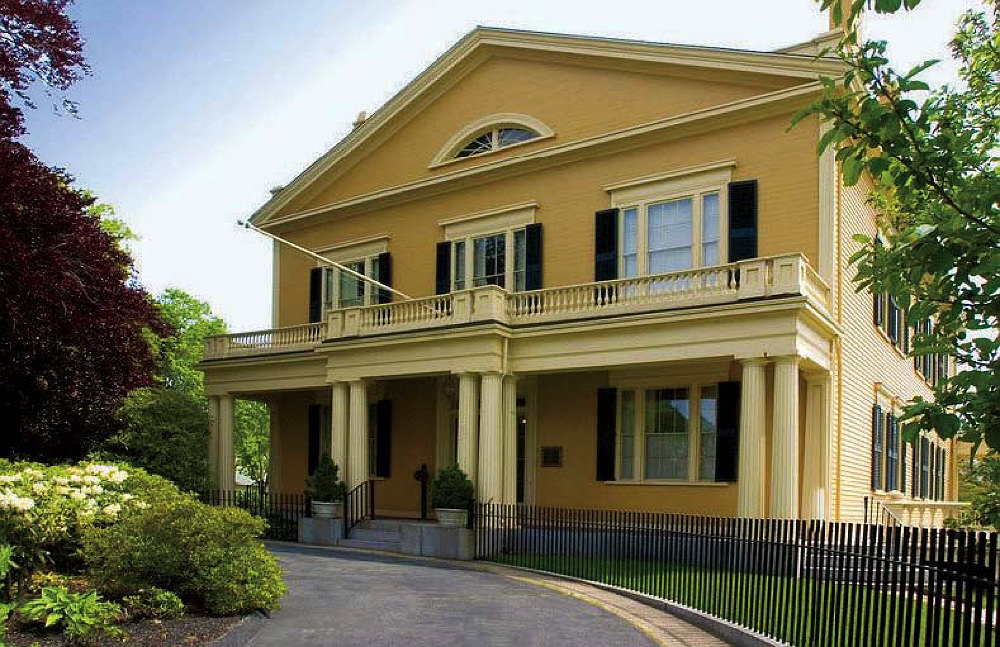
The Rotch-Jones-Duff House offers 150 years of history, and its rose garden blooms into the fall.
Tom Croke/Alamy Stock Photo.
For a 150-year perspective on the city’s growth and industries, and a sampling of wealthy lifestyles, head to the Rotch-Jones-Duff House & Garden Museum, a national landmark. The beautifully preserved Greek Revival mansion, designedby Richard Upjohn, was built in 1834 for whaling merchant William Rotch Jr. His father and enterprising grandfather had moved their Nantucket whaling assets and operations to what was then a small village on the Acushnet River. As a Quaker, the younger Rotch participated in the religious life of the Friends’ community, and, to some degree, in New Bedford’s anti-slavery efforts. Yet the Rotches were also keen businessmen.By 1823, more whaling vessels shipped out of New Bedford than Nantucket; the local population rose sevenfold between 1800 and 1830. The new railroad in 1840 expedited access to more whale-oil markets, and New Bedford became one of the richest communities in the world.
By the time Herman Melville boarded the whaling ship Acushnet in 1841, a transformational voyage that led to the writing of Moby Dick, his chapter-six description of New Bedford rang true. “But think not that this famous town has only harpooneers, cannibals, and bumpkins to show her visitors,” he wrote. “The town itself is perhaps the dearest place to live in, in all New England. It is a land of oil, true enough: but not like Canaan; a land, also, of corn and wine. The streets do not run with milk; nor in the spring-time do they pave them with fresh eggs. Yet, in spite of this, nowhere in all America will you find more patrician-like houses; parks and gardens more opulent, than in New Bedford.”
Among them was the Rotch-Jones-Duff House (it was subsequently owned by the Jones and Duff families before being opened as a museum in 1984). A tour highlights Greek Revival’s symmetrical designing ofwindows, doors, and fireplaces, along with fine craftsmanship. Although a man of simple tastes, William Rotch Jr. still owned collections of fine china and silverware, now displayed in the formal dining room. But it was the Duffs and Joneses who installed the black marble fireplaces, the chandeliers and ornate ceiling medallions, and stylish furnishings, even as they also supported the city’s overall prosperity.
Both families also developed the gardens, adding the extant Victorian pergola, ornamental flower beds, and paths among formal plantings that offer a wonderful sense of serenity. The grounds are open from sunrise to sunset, says facilities manager Rock Finneran, who is revitalizing the wildflower section while caring for American hollies, white ash, Norway spruce, and a copper beech planted more than a century ago. This summer’s garden events include poetry readings, plant tours, and plein air painting and yoga classes, along with Vaudeville Redux, a show and 1920s shindig (period-garb encouraged, July 22 and 23), and evening performances of Shakespeare’s comedy As You Like It (August 12-21).
From the southeast corner of the garden, Finneran points toward a vinyl-sided house at 47 South Sixth Street, originally built in 1838 for Mary Rotch (William Jr.’s sister), an important religious thinker and intellectual who influenced her good friend, Unitarian feminist Margaret Fuller, and Ralph Waldo Emerson.She was a progressive New Lights Quaker, among the group who split from the organized-religion approach of the Old Lights and believed that cultivating one’s “inner light”—not adherence to the Bible and strict codes of behavior and dress—connected one to the “supreme being.” Today, Rotch is among the women being rediscovered and honored as part of the whaling museum’s research and educational project Lighting the Way: Historic Women of SouthCoast.
Such intellectual ferment and a Quaker-based abolitionist community, combined with New Bedford’s thriving whaling industry and coastal trading routes, formed a promising destination for slaves escaping from the South. “A lot of runaway slaves could get jobs here,” Alison Wells says; although the whalers’ life was extremely taxing and dangerous, “for slaves, it was a form of freedom.” In 1838, Frederick Douglass, a caulker who’d worked among white men and freed slaves in the Baltimore shipyards, escaped slavery and, with the aid of New Bedford Quakers, made his way to the city with his wife, Anna.
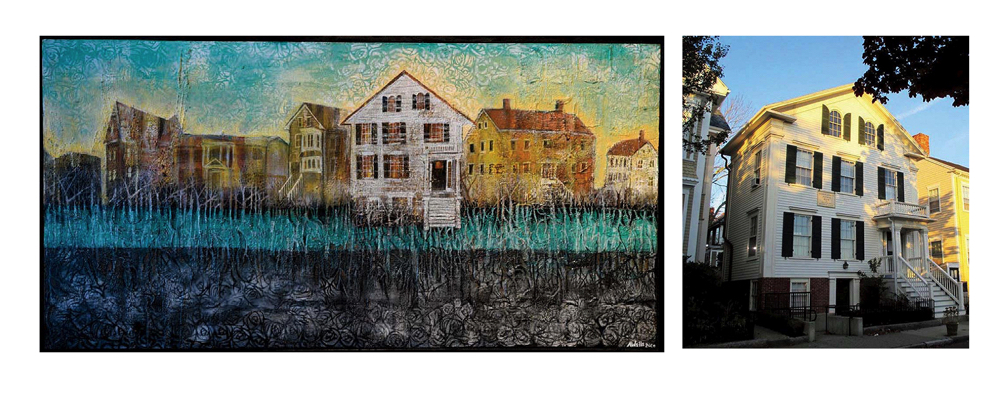
Wells’s painting Abolition Row Roots, at left, reflects the historic Johnson home where Frederick Douglass lived when he first arrived in New Bedford.
Alison Wells/Courtesy of the New Bedford Whaling Museum.
They landed at 21 Seventh Street, the home of Nathan and Mary “Polly” Johnson, prosperous African Americans who owned catering and confectionery businesses, and were local and national leaders of an anti-slavery movement that included other blacks and whites in New Bedford who also supported the Underground Railroad. William Rotch Jr. was good friends with fellow Quaker Captain Paul Cuffe, a businessman, educator—and probably the wealthiest man of color in the country in his lifetime, says Lee Blake, president of the New Bedford Historical Society. (Visitors can learn more about this enterprising, influential man through the whaling museum’s permanent exhibit “Captain Paul Cuffe: His Work, Vision, and Living Legacy.”) Blake reports that as late as 1860, Rotch was hiring fugitive slaves to work as domestics at his home. City abolitionists, she adds, had been aiding freedom seekers since 1792, “and self-emancipated persons came to the city in undetermined but probably high numbers through 1863.”
The all-volunteer historical society, which documents the history of the city’s people of color, bought the Johnson home in the late 1990s and has restored it. The home is part of a block of buildings the couple owned, including the old Society of Friends Meeting House, that are now a National Historic Landmark. The preservation society was also instrumental in transforming an adjacent vacant lot into Abolition Row Park, a public space that commemorates the local abolitionist movement. Construction began in the spring, and the park is slated to open in the fall. Due to exterior restoration work on the Johnson home this summer, that property is open for in-person tours only by appointment (email info@nbhistoricalsociety.org). Blake also recommends the self-guided and docent-led tours, “The Underground Railroad” and “Behind the Mansions Tour,” organized in conjunction with the national park. Look online, or go to the park’s downtown visitor’s center for details.
Around and between tours, allow time to browse the downtown’s boutiques and antique stores, as well as TL6 The Gallery and Gallery X, which sell works by regional artists. Locally owned restaurants, like Destination Soups, Arpeggio, and No Problemo, are also close at hand.
For an afternoon of greener destinations, head to Buttonwood Park, designed by the firm of Frederick Law Olmsted, A.M. 1864, LL.D. ’93, and its small but fine city-owned zoo, including an extensive collection of fish, coral, and other invertebrates. “We have an extremely expansive water-fowl collection,” adds assistant director Shara Rapoza, “and are heavily involved with the captive breeding and propagation of some of them, and other endangered species.” In 2019, the zoo partnered with the Red Panda Network, a leading conservation group based in Nepal, and the zoo is part of a species-survival plan through the Association of Zoos & Aquariums. The zoo created a panda habitat as part of efforts to support those missions; this June it celebrated the first birthday of its first cub, Kodo.

Buttonwood Park Zoo helps preserve red pandas, an endangered species.
Photograph courtesy of the Buttonwood Park Zoo.
To enjoy open sky and panoramic Buzzards Bay views, get out to Clark’s Point and Fort Taber Park at the southern tip of the city. It’s a short drive, but cyclists and avid walkers should also check out The Blue Lane, a series of waterfront, car-free paths—two of them, the Cove and Harbor walks, are completed—that will eventually connect communities from downtown to Clark’s Point. The point offers stretches of sandy-beach swimming along the park’s sunny and grassy zones for playing, picnicking, and lounging; fishing off the rocks is also allowed. A pedestrian path encircles the point and the impressive Civil War-era granite Fort Rodman, adjacent to the Fort Taber-Fort Rodman Military Museum and its small collection of artifacts and commemorative materials and cordoned-off gun batteries. A range of battle re-enactments are held seasonally..
The park is a popular destination for New Bedford’s historically diverse community, as Alison Wells illustrates in her kaleidoscopic painting Melting Pot. Stenciled plants, trees, and sunbursts overlay partial images of flag-bearing homes reflecting a cross-section of the city. “The American flag is dominant,” she notes, “but there are also Puerto Rican and Cape Verdean flags, a huge Portuguese flag, Guatemalan and LGBTQ flags—just showing unity. It’s a little different, because I usually strive to have a horizon line. But this one feels like everything is all over the place, with silhouettes of people, kids skipping rope, a man on his stoop, a guy walking his dog. It kind of feels like an optical illusion,” she says, “but it’s how we experience a place, with all kinds of things happening at once.”
